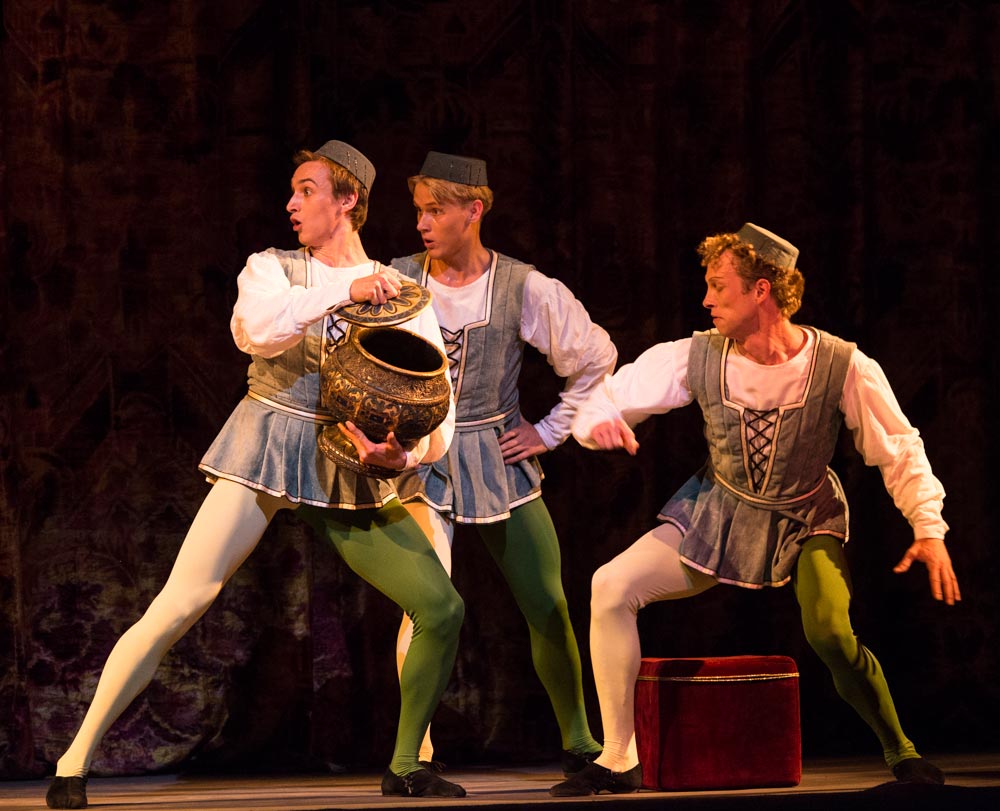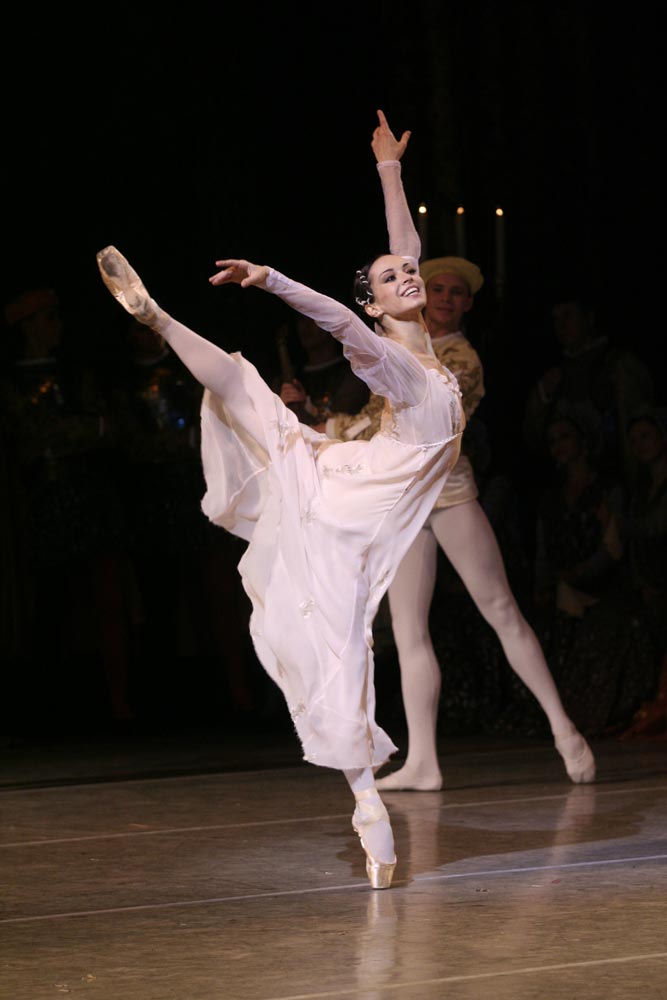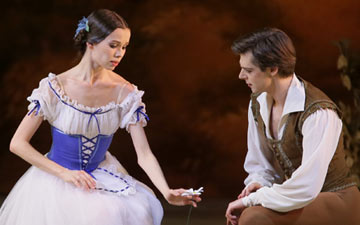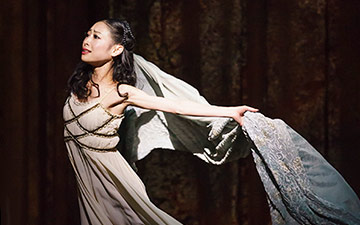
© Valentin Baranovsky. (Click image for larger version
Mariinsky Ballet
Romeo and Juliet – Diana Vishneva & Vladimir Shklyarov
London, Royal Opera House
28 July 2014
www.mariinsky.ru/en
www.roh.org.uk
Gallery of photos by Foteini Christofilopoulou – Viktoria Tereshkina, Xander Parish cast
When the Bolshoi Ballet first performed Leonid Lavrovsky’s Romeo and Juliet in London in 1956, audiences were overwhelmed by its dramatic intensity and lavish designs, as well as by Galina Ulanova’s performance as Juliet. When the ex-Kirov Ballet eventually introduced its own earlier production of the same ballet to London, it was regarded as dated, a pallid affair compared to Kenneth MacMillan’s familiar version for the Royal Ballet.
The Mariinsky company has dared to present its 1940 (more or less) production again at the start of its three-week summer season, in spite of the tepid reaction it received in 2009. This time, the first-night Juliet, Diana Vishneva, brought her understanding of MacMillan’s ballet, which she has danced with American Ballet Theatre, to Lavrovsky’s older version. Of course it’s dated, just as John Cranko’s 1962 account of Romeo and Juliet has dated. We forget how radically MacMillan broke ballet’s theatrical conventions in 1965, benefiting choreographers who followed later.
Scene changes in old theatres used to be covered by ‘cross-overs’, in which cast members carried on performing in front of a drop cloth while stage hands pushed sets in position. Ensemble dances ended in tableaux soliciting applause instead of melding into the action. Corps members stood politely aside, reacting in unison, when soloists took centre-stage. Although all these antiquated requirements are in the Lavrovsky production, they become insignificant interruptions to the impetus of the young lovers’ tragedy when the leading roles are taken by dancers as expressive as Vishneva and Vladimir Shklyarov.

© Foteini Christofilopoulou. (Click image for larger version)
Romeo opens the ballet as a romantic dreamer, meandering through Verona as its piazza awakens to merry-making and gang brawling. The Duke of Verona is an ineffective ruler whose decree against street fighting is soon ignored. Tybalt (Yuri Smekalov), in a preposterous multi-hued outfit, is the chief trouble stirrer; the grudge between Capulets and Montagues doesn’t otherwise seem deep-seated. Colour coding for rivals and entertainers in the crowd scenes is baffling. Costumes and palatial sets with painted Renaissance backdrops are from the originals by Piotr Williams (1902-1947).
Once the ballet’s focus shifts to Juliet, the production springs vividly to life. Vishneva’s Juliet is high-spirited, reluctant to grow up and ape her elders’ formal deportment. She’s evidently an indulged little princess, toasted by her admirers and the city’s VIPs at her parents’ ball. She is supremely confident, dancing like a flame about to set a hide-bound feudal society alight. But instead of paying attention to Paris (Konstantin Zverev), a preening popinjay, she is entranced by Romeo, who enters with his gate-crasher friends in the middle of her party piece.
A huge draped curtain descends to isolate the love-struck couple for their first pas de deux. Shklyarov reveals that his Romeo, hardly noticeable until this encounter, is a passionate fellow and fine dancer, boldly hoisting Juliet aloft above his head. Looking wonderingly down at him, she is overwhelmed by the rush of new feelings. She doesn’t yet foresee how fatal they will prove, unlike Ulanova in the 1955 film of the Bolshoi’s Romeo and Juliet. Ulanova captured Shakespeare’s entire tragedy in that bow of her head.

© Natasha Razina. (Click image for larger version)
When the lovers meet again on her balcony (which occupies the entire stage and which Romeo has no problem surmounting), they seem instant soul mates. They link together, each with an arm outstretched in what will be their signature pose. He hurtles away from her in flying leaps, only to return to uplift her again, her heart surging to the night sky in an abandoned shape that MacMillan would appropriate for his balcony pas de deux. Vishneva, though caught up in Juliet’s ecstasy, never overextends her beautiful arabesque line. She remains Lavrovsky’s unacrobatic heroine, even while she brings fresh ardour to the role.
Where this production scores is in the seriousness with which the young couple take their marriage vows. Their wedding scene is no hasty apology but a solemn ceremony conducted by a Friar Lawrence who is all too aware of mortality. Romeo copies him by contemplating a skull and a flower, before strewing a line of lilies for Juliet’s arrival. Several times they repeat their embrace with an arm outstretched on either side; they’ll recall their vows with the same embrace when they have to part after their only night together.
Lavrovsky also got in first with his treatment of Mercutio’s mocking death, Tybalt’s death throes to Prokofiev’s ominous chords, and Lady Capulet’s extravagant breast-beating on top of Tybalt’s bier as his corpse is borne away. Every choreographer since has had to find alternatives or be accused of imitation. Mariinsky performances, however, lurch all too easily over the top. Smekalov’s towering square-jawed Tybalt is a villainous thug who deserves no mourning. He’s been beastly to an innocent market trader as well as taking Mercutio (Alexander Sergeyev, suitably mercurial) unawares. Elena Bazhenova as Juliet’s beautiful mother is a ham as an actress; Vladimir Ponomarev scowls menacingly as Lord Capulet, bullying his daughter unmercifully.
At the start of Act II, the orchestra (the ballet company’s own) and conductor Boris Gruzin seemed disconcertingly at odds with the folk-dancing crowd. They couldn’t agree on tempi. Surprising, too, to have no mandolins for Prokofiev’s orchestration, which sounded thin. But Gruzin produced an extraordinarily sepulchral effect in Act III for Juliet’s unwilling reprise of her ballroom dance with Paris when she has to pretend to accept him as her future husband.

© Valentin Baranovsky. (Click image for larger version)
By then, Vishneva had transformed herself from a girl caught up in the delirium of first love to a bride conscious she risked soon becoming a widow. She appeared almost to dissolve in Shklyarov’s arms in their bedroom pas de deux, imploring him not to leave her. Her urgency was the more poignant because the dawn was clearly visible outside her window. Williams’s sets base the production in a realistic context that prevents its stylisation appearing too artificial. Even though Lavrovsky’s choreography for the bedroom scene is less expressive than MacMillan’s, these two dancers give it their own emotional power.
Vishneva knows how to wield Juliet’s cloak as she runs to and from Friar Lawrence’s chapel. She brings her post-Lavrosky awareness of Juliet’s revulsion at downing the potion and needing to seek the comfort of her bed. Romeo has been misled in exile by Benvolio informing him that Juliet is dead. Shklyarov’s tenderness as he kneels at her sepulchre, just as he knelt by her bed, marks his hard- won maturity by the end of his young life. Vishneva overdoes her reaction when she awakes and realises Romeo is dead, adding a clichéd silent scream to her frantic gestures. The starlit tomb at the end, surrounded by penitent mourners, is exquisite.

















You must be logged in to post a comment.